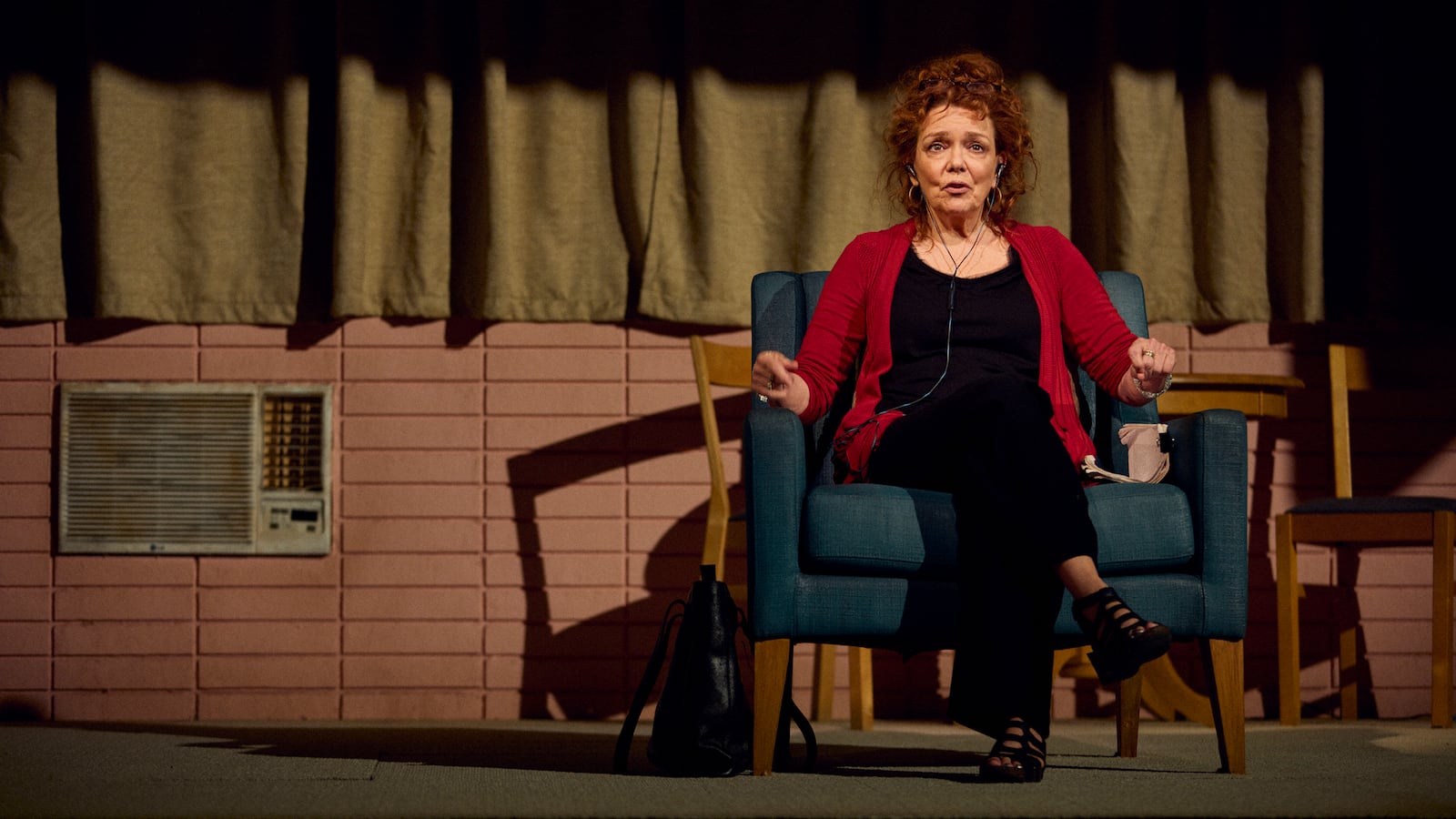Dana H., along with Is This A Room, were the best pieces of off-Broadway theater just before the pandemic hit. Now, karma doing its best kind of thing, the two Vineyard Theatre plays are playing at the same Broadway theater. Both are rooted in two very different traumatic real-life events, and both use words that were really said in the reciting of those real events.
While Is This A Room focuses on intelligence contractor Reality Winner’s FBI interrogation (using the transcript of that day), Dana H. reveals to the audience what happened in 1997 when Dana Higginbotham, mother of playwright Lucas Hnath, was kidnapped and held hostage for five months, her terrifying captor “Jim” moving her from motel to motel in a horrific, nightmarish road trip.
Hnath—multi-award-winning playwright of productions including A Doll’s House, Part 2—has crafted Dana H. It is around 75 minutes long, and directed by Les Waters, starring a transfixing Deirdre O’Connell as Hnath’s mother. O’Connell first takes her seat on Andrew Boyce’s set, which evokes a nondescript motel room. She is wired up to a microphone and earbuds by stage hand. We learn via surtitles that she will lip-sync Higginbotham’s words, as recorded in an edited interview conducted by a theatrical colleague of Hnath’s, Steve Cosson.
And so this astonishing exercise begins. It is not just lip-syncing, though, which implies a very basic act of impersonation or mimicry. For one, O’Connell masters every rustle, movement of the body, caught breath, laugh, rise of emotion. Every sound that is on tape, every pause, everything is replicated by her. But she also inhabits the character of Higginbotham commandingly too, sitting there, facing us.
The play begins and ends with a meditation on death. Higginbotham, in her regular life, is a hospital chaplain who helps people and their loved ones prepare for death, this after her own life was taken away from her by her violent assailant and abuser. He begins as a referral whose notes she scans—“he was in Folsom, San Quentin, Pelican Bay, uh for inciting riots, uh carjackings, uh attempted murders.”
He is a criminal and a member of an extremist hate group—the play’s producers have asked journalists not to name this group in reviews, which seems weird as Hnath himself does so in the play, many times—and explaining its influence is one reason Dana feels so trapped and imperiled. Why name the group in the play so often? The media, yes, could amplify the name by saying it, but it’s curious to ask the media not to invade your privacy and potentially endanger safety when you have done the same in such unsparing detail in the name of art. One would have thought the people not being named may know about the play whatever the media draws a veil over in these reviews.
Jim first stays with Dana, sleeping on the couch downstairs. He slept on the couch downstairs: “I remember him sharpening the pen... to make a weapon.” There is a bloody suicide attempt. It is odd, the lack of professional boundaries, especially around someone so dangerous, but this is not elaborated upon.
Eventually, Jim throws himself through Dana’s window and kidnaps her. And so her nightmare begins. The threat of death, and extreme violence, is what he uses to prevent her from escaping. She is in situations—in cafes, and public places—where she wants to make a break for it or try to tell someone what is happening. But she cannot.
Higginbotham finds herself drawn deeper into his web of madness, with receding opportunities of escape. Every encounter with a cop ends with the kidnapper and the cop chumming up. The one time a cop tells her to make a run for it and he will hold Jim for as long as he can, Jim simply catches up to her again, and her captivity continues. She says—and this is perhaps a mixture of his use of coercive control and Stockholm Syndrome—that she came to see him as her protector and that she was envious he had parlayed his anger into actually killing someone, as she herself had wanted to do on occasion. Jim eventually rapes her, violently.
O’Connell’s gallery of facial expressions and gestures conveys confusion, fear, and brutalization—and occasionally, amazingly, humor. We feel increasing, wrenching desperation watching this story of abuse and imprisonment, although more and more frustrated with Cosson as an interviewer. He asks questions, but they are of the extremely basic kind. Perhaps he was being understandably gentle with his friend’s mom, but interviews are interviews, and a play is a play—and too much in Dana H. is simply left unasked and unanswered.
We do hear of her rescue and then an embracing of a new life of manual steelwork—and Jim’s apparent vanishing from her life. But the play prompts so many questions—about her captivity, the lack of response to it, and what happened afterward.
The text doesn’t make clear if law enforcement generally knew and was trying to find her (she has occasional not very helpful encounters with local enforcement), but it seems odd that Higginbotham was kidnapped and essentially left her life for five months, and no family or authorities took notice of this, or proactively attempted anything to return her to safety. Maybe they did, and it is not related here.
Dana H. stunningly escapes its own stage bounds near the end, when Waters, lighting designer Paul Toben, and sound designer Mikhail Fiksel bring the motel room to loud, insane life to convey the disorientation and terror—and geographical dislocation—that Higginbotham endured in so many different motel rooms at the hands of Jim.
An uncredited actor playing a maid tidies the room (that is really many rooms) in this interlude before O’Connell returns to the stage to complete her act of theatrical virtuosity—and nothing that is missing from the dramatic account of the play diminishes that virtuosity. This is a singular, richly nuanced performance. Go and see it.







